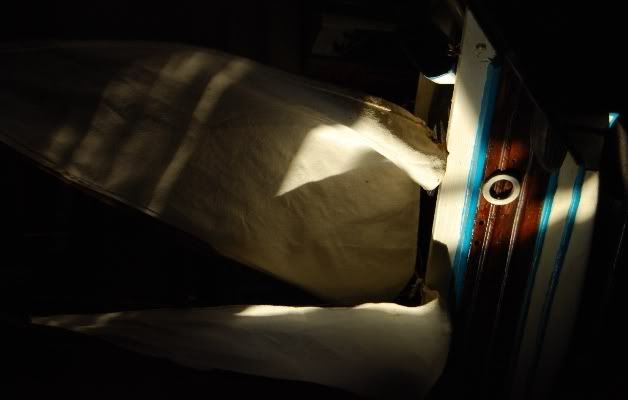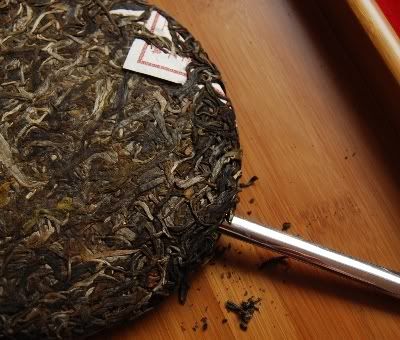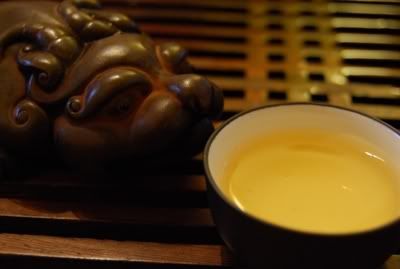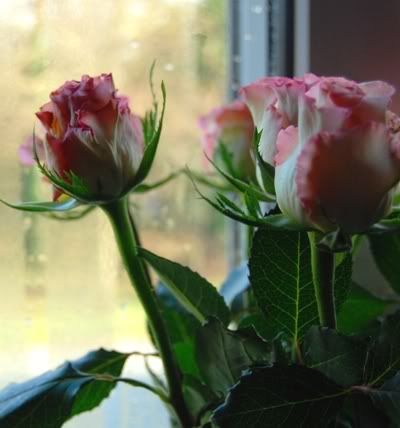Home-made things are very popular with me. There's magic in a creation made with care, by someone who put a little of themselves into it. Returning home over Christmas, I spent some time photographing items from my childhood that remain in my family home. Quite a lot of it remains, in fact, given that my parents seem to throw nothing out. We're a sentimental bunch. Hunt around long enough, and in some dark corner you'll always find what you're after.
In this case, it's a boat made by my father (below), which I used to delight in playing with as a boy. It looks as new as the day I left it, decades ago. Even the rigging, wheel, and rudder still function. I suspect this is due to the homeostasis which surrounds all of our old toys and games, now sacred artefacts too revered to discard.
In this case, it's a boat made by my father (below), which I used to delight in playing with as a boy. It looks as new as the day I left it, decades ago. Even the rigging, wheel, and rudder still function. I suspect this is due to the homeostasis which surrounds all of our old toys and games, now sacred artefacts too revered to discard.
The subject of today's article is a hand-made cake, pictured below, specified by distributors in Kunming, previously made in 2003, 2005, and 2007. The latter were apparently sold to the Kunming branch of the Bank of China to use as gifts. I like to imagine a thrilled tea enthusiast receiving these cakes and enjoying them at home with friends. Given the practices of PRC business (and banks in particular), a nagging doubt tells me that their fate is something altogether more vulgar, but hope remains.
The vendor description tells us that these claim to be produced using leaves from 400-500 year-old wild trees that were cut heavily during the Cultural Revolution, but which have since regrown in the last 35 years. Who knows to what extent this is true, but, again, hope remains.
The vendor description tells us that these claim to be produced using leaves from 400-500 year-old wild trees that were cut heavily during the Cultural Revolution, but which have since regrown in the last 35 years. Who knows to what extent this is true, but, again, hope remains.
Immediately striking is the fact that the wrapper has changed from its initial white to a mangy yellow in the three months that I have owned it. Shown above, a recent Menghai cake for comparison, to give you an idea of the discolouration of the wrapper. Surely a minor point, but this indicates that a very cheap type of paper has been used - the highly acidic variety typically used to print "pulp fiction", such as romance novels.
For cheap books, this is appropriate: the life expectancy of a Mills and Boon romance is the few days it takes for the book to be read, then discarded. For tea of supposed quality, though, which is presumably intended to be aged for many years, the choice of dirt-cheap pulp paper is surprising. How else have the producers decided to try and cut corners to save the odd yuan? Concerns abound as to how the acid in the paper will interact with the leaves over the years.
For cheap books, this is appropriate: the life expectancy of a Mills and Boon romance is the few days it takes for the book to be read, then discarded. For tea of supposed quality, though, which is presumably intended to be aged for many years, the choice of dirt-cheap pulp paper is surprising. How else have the producers decided to try and cut corners to save the odd yuan? Concerns abound as to how the acid in the paper will interact with the leaves over the years.
That said, I rather like the "chan" character written in seal-script in the centre of the wrapper, which means dhyana/zen.
I really want to like this cake. Buy four and get a charming hand-woven basket to contain the xiaobing, so the advertisement reads. I'm a real sucker for good packaging. A "Zen" cake in a hand-made basket has pretty much sealed the deal before I even open the wrapper.
That said, I have found it a real struggle to understand this cake. I've had three long sessions with it since autumn, and have yet to really pin it down.
That said, I have found it a real struggle to understand this cake. I've had three long sessions with it since autumn, and have yet to really pin it down.
It's yellow, as you can see from the above picture. Honest, lovely yellow. Its aroma is an orthodox, yet potent, sweetness. If I didn't actually sip the tea, I would probably have bought a few baskets.
A total of 42 infusions (over the courses of the three sessions) later, and sufficient doubt remains that I won't buy any more than the single investigatory cake I have. It opens very well: chunky mushrooms, a cooling sensation, a noticeable huigan.
By the third and fourth infusions, floral notes are appearing in the nose: "This tea has an elegant aroma, something like rose", says Lei.
"The chaqi is strong in this one", she adds innocently, which causes me to snigger, recalling my Star Wars-addled childhood memories of Darth Vader saying something similar about The Force.
So what's wrong with it?
Something's missing for me. Bearing in mind that I really (really) wanted to like this one, there's just something flat about it that doesn't make me want to buy more. I was sitting on the fence for a long time, until Lei sagely noted, "If you still have doubts after drinking it so much, don't buy it." Fair enough.
It has that "brown" character that I sometimes allude to: as of cabbage leaves left out in the air, to turn brown. It's a bit "off", in that way, as if some unbeneficial reaction has occurred with the air at some point during its processing.
Tea is a personal thing. I can easily imagine others loving this one. My concluding uncertainty, it's failure to grab me, counts it out as far as I'm concerned, but do let me know if you've enjoyed it. Maybe I'm just looking for something with a bit more punch, a little bit more challenge.
(In the last session, I added more dry leaves to the tenth infusion to pep it up: the thick mushroom character returned, as did the cooling sensation. It definitely has its moments.)
A total of 42 infusions (over the courses of the three sessions) later, and sufficient doubt remains that I won't buy any more than the single investigatory cake I have. It opens very well: chunky mushrooms, a cooling sensation, a noticeable huigan.
By the third and fourth infusions, floral notes are appearing in the nose: "This tea has an elegant aroma, something like rose", says Lei.
"The chaqi is strong in this one", she adds innocently, which causes me to snigger, recalling my Star Wars-addled childhood memories of Darth Vader saying something similar about The Force.
So what's wrong with it?
Something's missing for me. Bearing in mind that I really (really) wanted to like this one, there's just something flat about it that doesn't make me want to buy more. I was sitting on the fence for a long time, until Lei sagely noted, "If you still have doubts after drinking it so much, don't buy it." Fair enough.
It has that "brown" character that I sometimes allude to: as of cabbage leaves left out in the air, to turn brown. It's a bit "off", in that way, as if some unbeneficial reaction has occurred with the air at some point during its processing.
Tea is a personal thing. I can easily imagine others loving this one. My concluding uncertainty, it's failure to grab me, counts it out as far as I'm concerned, but do let me know if you've enjoyed it. Maybe I'm just looking for something with a bit more punch, a little bit more challenge.
(In the last session, I added more dry leaves to the tenth infusion to pep it up: the thick mushroom character returned, as did the cooling sensation. It definitely has its moments.)






I was just about to try this one from the group buy, but I'm still overrun with way too many samples. I'll return to your notes after I've had a session or two with this. After having tried the Hai Lang Hao Banzhang Man'e cake, anything with banzhang in the name has quite a lot to live up to!
ReplyDeleteAlso if you've tried the big classic, I'd be interested in your opinion on it. I hope I haven't lost my mind owning a tong of it.
Dear Bryan,
ReplyDeleteI'm glad the group buy got into this one! It's a real enigma. I really can't decide whether to love it or ignore it.
The 2008 Menghai "Big Classic" (801) is up soon - maybe even this afternoon, if I call it a day early. :)
Toodlepip,
Hobbes
Hobbes,
ReplyDeleteIt's been a long time! Hope all is well. I agree with Bryan on the Hai Lang Hao Lao Banzhang/Lao Man'e. Absolutely amazing! Just be warned, it's not forgiving of an overnight brew like most other pu-erh. When it is cold it is unforgiving tyrant! I hope I'm not off my rocker for buying a tong of it!
Jamus~
Hi,
ReplyDeleteDo you sell the teas that you talk about in your blog?
If not where do you buy most of them?
Dear Jamus,
ReplyDeleteIt certainly has been a while! I do like that Hailanghao cake, too - it really holds the attention. A tng is a bold move indeed, and I can see why you'd be so inclined. I'm eyeing it, myself. :)
Toodlepip,
Hobbes
Dear Anonymous,
ReplyDeleteI think I'd make a fairly rubbish tea seller. Ask the poor souls who have received tea samples from me - I'm very slow. I'm sure customers would soon go elsewhere if it took an extra week or two for their tea to arrive. :)
The teas I drink usually come from the popular on-line vendors, which I try to mention in the articles themselves - if you want to know where a particular tea comes from, do please let me know. The Wild Arbor tea in this article, for example, comes from Yunnan Sourcing.
Other popular vendors include Houde, Dragon Tea House, Puerh Shop, Nadacha, Skip4Tea, Jing Tea Shop, and others.
Toodlepip,
Hobbes
My opinion of this tea pretty much mimics yours, somethings missing. Rather thin and hallow. Ive had all the versions of these teas and found them all to be not up to snuff. Except for the 2009 Spring Harvest. This one is much rounder, fuller and sweeter than the previous years teas. I too almost fell for that basket full of cakes. Glad I tried them first.
ReplyDelete